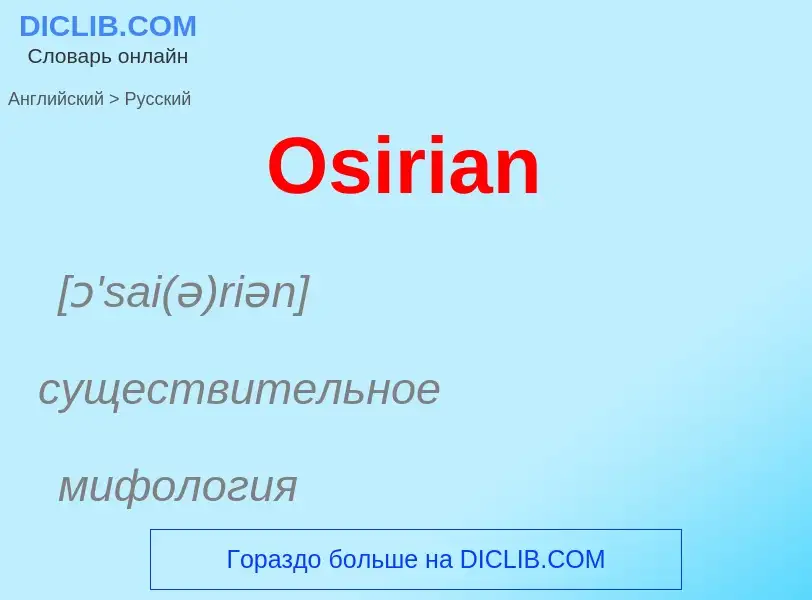Перевод и анализ слов искусственным интеллектом ChatGPT
На этой странице Вы можете получить подробный анализ слова или словосочетания, произведенный с помощью лучшей на сегодняшний день технологии искусственного интеллекта:
- как употребляется слово
- частота употребления
- используется оно чаще в устной или письменной речи
- варианты перевода слова
- примеры употребления (несколько фраз с переводом)
- этимология
Osirian - перевод на русский
[ɔ'sai(ə)riən]
существительное
мифология
относящийся к Озирису
[ɔ'sai(ə)ris]
существительное
мифология
Озирис
Определение
Википедия
.jpg?width=120)
Osiris (, from Egyptian wsjr, Coptic: ⲟⲩⲥⲓⲣⲉ ousire, Late Coptic [uˈsiræ]; Phoenician: 𐤀𐤎𐤓, romanized: ʾsr) is the god of fertility, agriculture, the afterlife, the dead, resurrection, life, and vegetation in ancient Egyptian religion. He was classically depicted as a green-skinned deity with a pharaoh's beard, partially mummy-wrapped at the legs, wearing a distinctive atef crown, and holding a symbolic crook and flail. He was one of the first to be associated with the mummy wrap. When his brother Set cut him up into pieces after killing him, Osiris' wife Isis found all the pieces and wrapped his body up, enabling him to return to life. Osiris was widely worshipped until the decline of ancient Egyptian religion during the rise of Christianity in the Roman Empire.
Osiris was at times considered the eldest son of the earth god Geb and the sky goddess Nut, as well as being brother and husband of Isis, and brother of Set, Nephthys, and Horus the Elder, with Horus the Younger being considered his posthumously begotten son. Through syncretism with Iah, he was also a god of the Moon.
Osiris was the judge and lord of the dead and the underworld, the "Lord of Silence" and Khenti-Amentiu, meaning "Foremost of the Westerners". In the Old Kingdom (2686–2181 BC) the pharaoh was considered a son of the sun god Ra who, after his death, ascended to join Ra in the sky. After the spread of the Osiris cult, however, the kings of Egypt were associated with Osiris in death – as Osiris rose from the dead, they would unite with him and inherit eternal life through imitative magic.
Through the hope of new life after death, Osiris began to be associated with the cycles in nature, in particular the sprouting of vegetation and the annual flooding of the Nile River, as well as the heliacal rising of Orion and Sirius at the start of the new year. He became the sovereign that granted all life, "He Who is Permanently Benign and Youthful".
The first evidence of the worship of Osiris is from the middle of the Fifth Dynasty of Egypt (25th century BC), although it is likely that he was worshiped much earlier; the Khenti-Amentiu epithet dates to at least the First Dynasty, and was also used as a pharaonic title. Most information available on the Osiris myth is derived from allusions in the Pyramid Texts at the end of the Fifth Dynasty, later New Kingdom source documents such as the Shabaka Stone and "The Contendings of Horus and Seth", and much later, in the narratives of Greek authors including Plutarch and Diodorus Siculus.
Some Egyptologists believe the Osiris mythos may have originated in a former living ruler – possibly a shepherd who lived in Predynastic times (5500–3100 BC) in the Nile Delta, whose beneficial rule led to him being revered as a god. The accoutrements of the shepherd, the crook and the flail – once insignia of the Delta god Andjety, with whom Osiris was associated – support this theory.

.jpg?width=200)

![Twenty-second Dynasty]], [[Louvre]], [[Paris]]) Twenty-second Dynasty]], [[Louvre]], [[Paris]])](https://commons.wikimedia.org/wiki/Special:FilePath/Jewel Osiris family-E 6204-IMG 0641-gradient.jpg?width=200)


![Judgment scene from the [[Book of the Dead]]. In the three scenes from the [[Book of the Dead]] (version from ~1375 BC) the dead man ([[Hunefer]]) is taken into the judgement hall by the jackal-headed [[Anubis]]. The next scene is the weighing of his heart against the feather of [[Ma'at]], with [[Ammut]] waiting the result, and [[Thoth]] recording. Next, the triumphant Hunefer, having passed the test, is presented by the falcon-headed [[Horus]] to Osiris, seated in his shrine with Isis and [[Nephthys]]. (British Museum) Judgment scene from the [[Book of the Dead]]. In the three scenes from the [[Book of the Dead]] (version from ~1375 BC) the dead man ([[Hunefer]]) is taken into the judgement hall by the jackal-headed [[Anubis]]. The next scene is the weighing of his heart against the feather of [[Ma'at]], with [[Ammut]] waiting the result, and [[Thoth]] recording. Next, the triumphant Hunefer, having passed the test, is presented by the falcon-headed [[Horus]] to Osiris, seated in his shrine with Isis and [[Nephthys]]. (British Museum)](https://commons.wikimedia.org/wiki/Special:FilePath/The judgement of the dead in the presence of Osiris.jpg?width=200)
